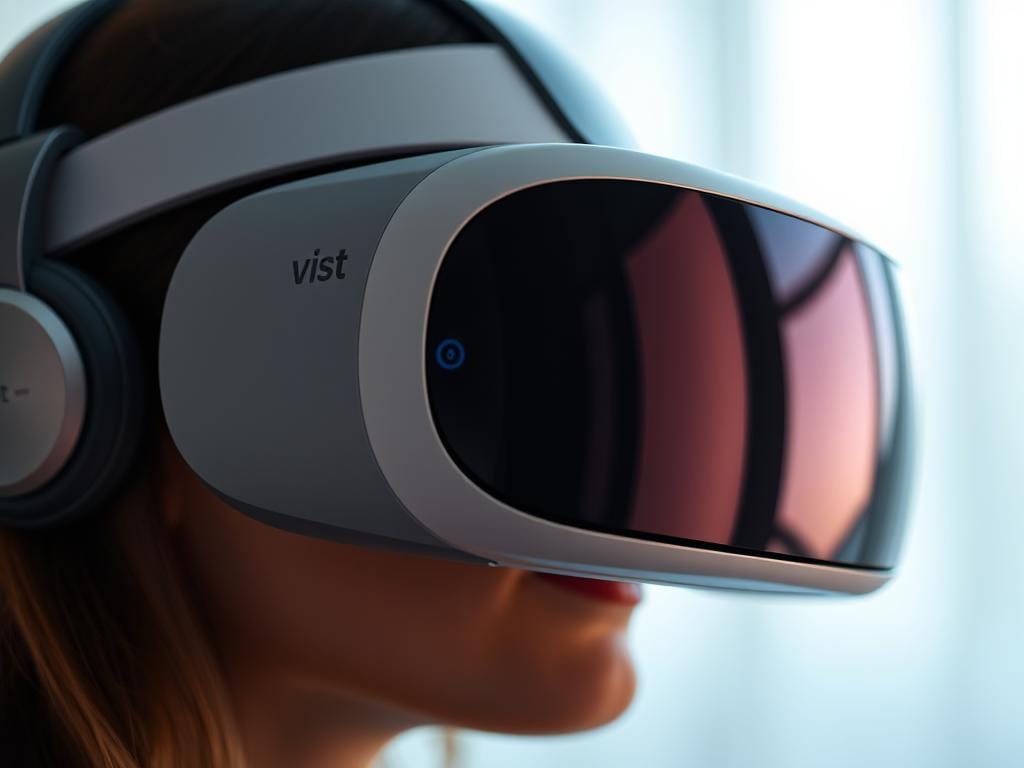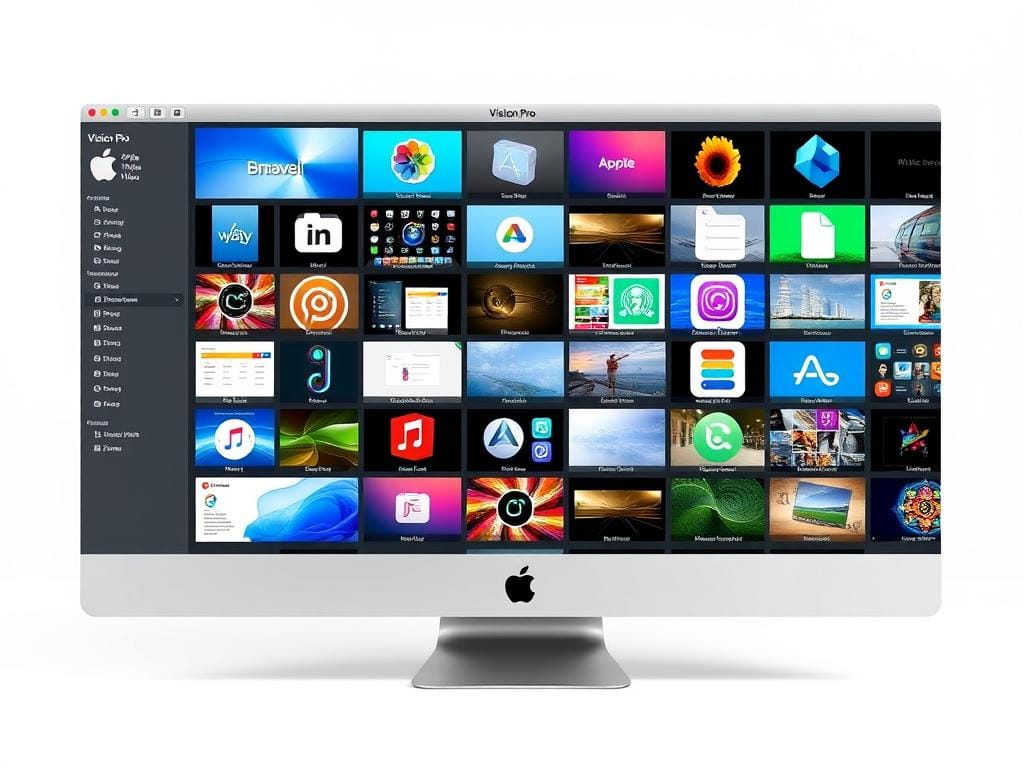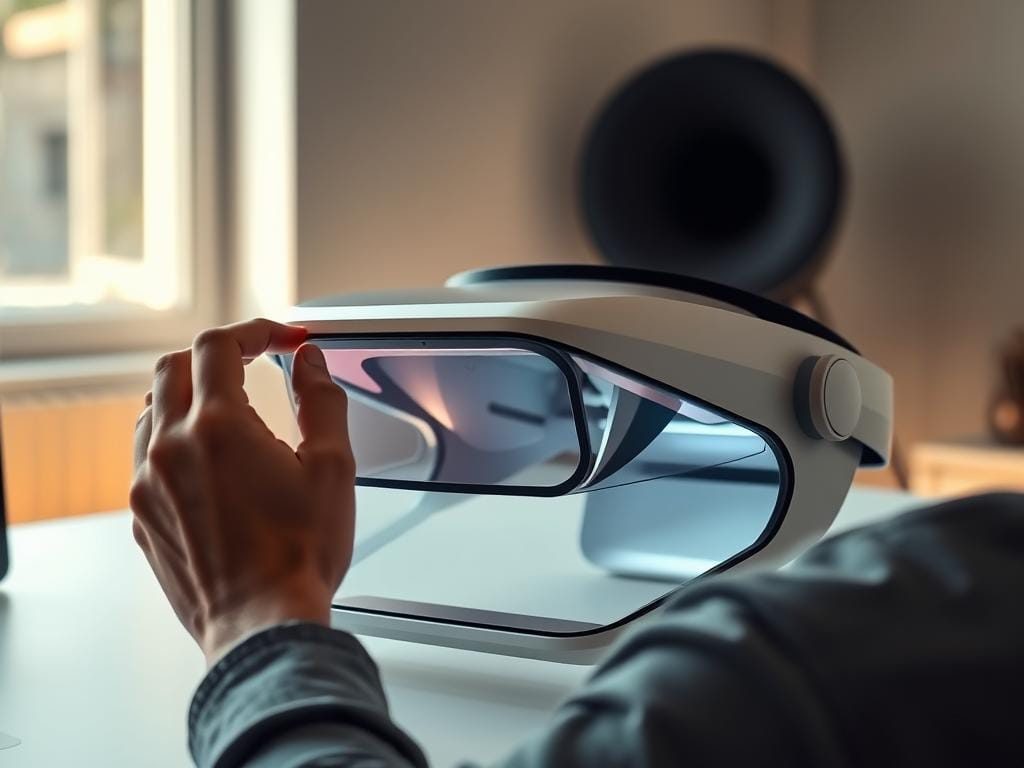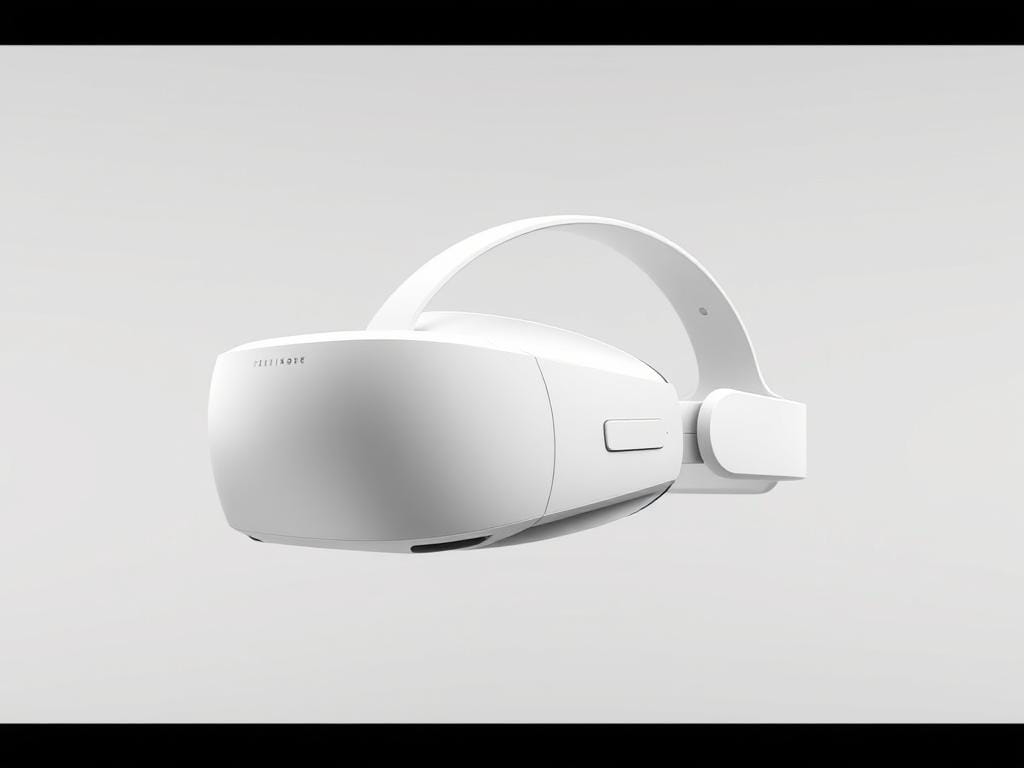A year after its release, the Vision Pro continues to impress with moments of magic, particularly when watching movies or using it as a giant curved monitor for a Mac computer.
We are diving deep into the Vision Pro experience in 2025 to determine if this premium headset has evolved into the revolutionary computing device promised by its creators.
The $3,500 price tag of the Vision Pro demands substantial value in return. We’ve explored its hardware quality, comfort, software capabilities, and real-world applications to see if it delivers.
Key Takeaways
- The Vision Pro remains a bleeding-edge tech showcase and the most advanced standalone VR/AR headset.
- Software updates and ecosystem expansions have enhanced its capabilities since its initial release.
- It offers an immersive experience, particularly for entertainment and productivity.
- New competitors have emerged in the spatial computing market since its launch.
- We’ll examine whether the Vision Pro has overcome its initial limitations.
The Vision Pro Experience: First Impressions

As we dive into the Apple Vision Pro experience, it becomes clear that this device is more than just a headset – it’s a gateway to a new dimension of computing. The Vision Pro offers an immersive experience that’s both captivating and intuitive.
Design and Build Quality
The Apple Vision Pro’s design and build quality are exceptional, reflecting Apple’s attention to detail and commitment to creating a premium product. The device feels like a natural extension of the Apple ecosystem, with a sleek and modern aesthetic that is both visually appealing and durable.
Setup and Initial Use
The setup process for the Vision Pro is streamlined and user-friendly, guiding users through eye tracking calibration, hand gesture tutorials, and Apple ID integration. The initial configuration feels intuitive, especially for those already familiar with Apple’s iOS ecosystem.
Some key aspects of the setup and initial use include:
- The Vision Pro’s setup process remains one of the most streamlined in the XR space.
- Initial configuration feels intuitive for those already in the Apple ecosystem.
- The eye and hand tracking calibration process is thorough and essential for the proper functioning of the device’s unique control system.
- First-time users are often surprised by how quickly they adapt to the Vision Pro’s interface.
Overall, the Apple Vision Pro is a significant step forward in XR technology, offering a compelling experience that combines innovative design with user-friendly functionality. As a device, it sets a new standard for what we expect from such products.
Hardware Capabilities of the Apple Vision Pro

Delving into the hardware of the Apple Vision Pro reveals a sophisticated device designed to push the boundaries of computing. The Vision Pro is equipped with advanced components that work together to provide a seamless user experience.
Display Technology and Visual Experience
The display technology in the Apple Vision Pro is one of its standout features. With high-resolution displays, the device offers a crisp and vibrant visual experience. The screen is designed to provide a wide field of view, making it ideal for immersive applications.
The advanced display technology ensures that visuals are rendered with precision and clarity, enhancing the overall user experience.
Audio Quality and Spatial Sound
The Apple Vision Pro also boasts impressive quality audio capabilities, with spatial sound technology that simulates a three-dimensional audio environment. This feature is particularly beneficial for gaming and multimedia consumption, as it provides a more immersive experience.
Battery Life and Power Management
The battery pack of the Apple Vision Pro offers approximately 2-3 hours of typical use, which remains a limitation since its launch. However, power management has been improved through software updates, allowing for more efficient background processing. The external battery pack design allows for hot-swapping or connection to external power sources, making it more versatile.
For instance, plugging the headset‘s battery pack into an under-seat outlet can provide continuous power, mitigating the concern of running out of battery during extended use.
Interface and Controls: A New Way to Compute
The Apple Vision Pro introduces a revolutionary interface that combines eye tracking and gesture controls, redefining how we interact with technology. This new way of computing promises to be more intuitive and immersive, leveraging the user’s eyes and hands to navigate through various applications and tasks.
Eye Tracking and Gesture Controls
The Vision Pro’s eye tracking system is remarkably precise, allowing users to select items on the screen simply by looking at them. When combined with hand gestures, this creates a powerful and intuitive control mechanism. For instance, a finger gesture that doubles as a mouse click is generally smart and works well, although there are instances where the system misinterprets the gesture, causing unintended actions like scrolling a window. Despite these occasional issues, the overall experience is innovative and engaging.
Navigation and User Experience
Navigating the Vision Pro is designed to be straightforward, with an interface that responds to natural gestures and eye movements. The user experience is enhanced by the ability to manipulate virtual objects and windows with ease, creating a seamless interaction with the digital environment. However, there are moments when the system’s interpretation of gestures can be problematic, such as when typing and inadvertently triggering other actions.
Learning Curve and Accessibility
The Vision Pro’s accessibility features have been significantly expanded, offering improved voice control, alternative gestures for users with limited mobility, and visual accommodation options. While the learning curve remains steeper than conventional interfaces, Apple has refined the onboarding process with interactive tutorials to help users become fluent in the spatial interface. The device’s physical design also accommodates different head shapes and comfort needs, though the headset’s weight remains a challenge for extended use.
| Feature | Description | Benefit |
|---|---|---|
| Eye Tracking | Precise tracking of user gaze | Intuitive selection of items on screen |
| Gesture Controls | Hand gestures for navigation and interaction | Natural and immersive user experience |
| Accessibility Features | Voice control, alternative gestures, visual accommodations | Enhanced usability for users with limited mobility |
Software Ecosystem and App Availability

A key aspect of the Apple Vision Pro experience is its software ecosystem, which is shaped by the range and quality of available apps. The device’s capabilities are significantly enhanced by the variety of applications that are designed to work seamlessly with its advanced features.
Built-in Applications and Functionality
The Apple Vision Pro comes with a suite of built-in applications that are designed to showcase its capabilities. These include apps for productivity, creativity, and entertainment. While some of these apps are adapted from other Apple devices, they have been optimized to take full advantage of the Vision Pro’s features.
For instance, the Photos app allows users to view and interact with their memories in an immersive environment. The device also includes a range of other built-in apps, such as a web browser and a mail client, which provide a seamless user experience.
Third-Party App Support
The Vision Pro has attracted a growing number of third-party developers who are creating apps tailored to the device. These apps range from productivity tools to games and entertainment experiences. While the selection is still growing, there are already some standout titles that demonstrate the potential of the platform.
Developers are leveraging the Vision Pro’s advanced features, such as eye tracking and gesture controls, to create innovative and engaging experiences. However, the lack of some key apps, such as a Vision Pro-ified version of Final Cut, is still a notable omission.
Gaming and Entertainment Options
The gaming ecosystem on Vision Pro has expanded to include more immersive experiences, although it still lags behind dedicated VR headsets in terms of quantity and depth. Apple Arcade integration provides a selection of games optimized for the spatial interface, but many are adaptations rather than ground-up spatial gaming experiences.
Entertainment apps for streaming services have broadly adopted the Vision Pro, offering virtual theater experiences that showcase the headset’s display capabilities. However, immersive entertainment experiences designed specifically for the Vision Pro remain relatively scarce.
Real-World Applications and Use Cases
 eight=”768″ />
eight=”768″ />
As we dive into the real-world applications of the Apple Vision Pro, it’s clear that this device is more than just a cutting-edge gadget. The Vision Pro is designed to be a versatile tool that can be applied in various aspects of our lives, from productivity and work to entertainment and social interaction.
Productivity and Work Applications
The Apple Vision Pro has shown significant potential in enhancing productivity and work applications. With its advanced features, users can create a virtual monitor setup, allowing for multiple windows and applications to be open simultaneously, increasing efficiency and multitasking capabilities. Collaborative work applications have also begun to leverage the spatial capabilities of the Vision Pro, enabling shared virtual workspaces and document review. For instance, users can work on a project together in real-time, using the Vision Pro to share and interact with 3D models or presentations.
- Enhanced multitasking capabilities with multiple virtual windows
- Collaborative work applications for shared virtual workspaces
- Improved productivity with advanced spatial features
Entertainment and Media Consumption
The Vision Pro also offers an immersive experience for entertainment and media consumption. Users can watch a movie on a large virtual screen, or play games that take advantage of the device’s spatial audio and visual capabilities. The Vision Pro can transform any environment into a personalized cinema, providing an engaging and interactive experience.
For example, users can enjoy their favorite movies or TV shows on a virtual screen that can be placed anywhere in their surroundings, making it feel like they’re in a private cinema.
Social Interaction and Communication
While the Vision Pro offers many benefits, it also raises concerns about social isolation. As one user noted, “My wife doesn’t like it when I’m wearing the Vision Pro. She says it makes me ‘very unapproachable’.” The EyeSight feature, which simulates the user’s eyes on the external screen, has seen improvements but still creates a sense of disconnection. However, social applications on the Vision Pro have evolved to include more spatial elements, enhancing video conferencing and virtual interactions.
- Improved social applications with spatial elements
- Enhanced video conferencing with spatial features
- EyeSight feature for better interaction awareness
In conclusion, the Apple Vision Pro has a wide range of real-world applications, from productivity and work to entertainment and social interaction. While there are challenges to be addressed, the device has the potential to revolutionize the way we live and work.
Conclusion: Is the Apple Vision Pro Worth It in 2025?
The Vision Pro has shown us glimpses of the future of computing, but its current form is still a work in progress. At $3,500, it’s a luxury device that showcases what’s possible in spatial computing, but its value proposition remains complicated due to its premium <strong>price.
While the Vision Pro excels as a media consumption device, particularly for those who value high-quality visual experiences and have the disposable income to invest in premium entertainment technology, its adoption is limited by several factors. The physical form factor continues to be a limiting factor, with comfort challenges arising from wearing the headset for extended periods.
For professionals in specific fields, such as those working with 3D content or complex data visualization, the Vision Pro can justify its cost through productivity enhancements. However, for everyday consumers, it remains difficult to justify as a replacement for existing devices, functioning better as a complement to the Apple ecosystem than as a standalone computing solution.
The Meta Quest devices offer compelling alternatives at a fraction of the price, intensifying competition in the spatial computing market. As Apple figures out how to make the Vision Pro more accessible and user-friendly, it needs to overcome the challenge of getting Vision on more faces for less while enhancing its capabilities.
Looking ahead, the Vision Pro’s legacy may ultimately be as a pioneering device that helped define spatial computing standards. For those already deeply invested in the Apple ecosystem with specific use cases that benefit from spatial computing, the Vision Pro offers unique capabilities that can’t be found elsewhere. The fundamental question remains whether the Vision Pro represents the future of computing – while it demonstrates compelling possibilities, its current incarnation feels more like a glimpse of the future than its full realization.
🚀 Unlock the Future of Technology Today! 🚀
Dive into our latest blog article, “Gemini Devices: Redefining the Tech Experience,” and discover how these groundbreaking gadgets are transforming the way we interact with technology. Whether you’re a tech enthusiast or just looking to elevate your daily routine, Gemini Devices offer unparalleled performance and innovation that you simply can’t miss!
Don’t let this opportunity slip away—read the article now to explore exclusive insights, expert reviews, and tips on how to make the most of your Gemini experience.
👉 Click Here to Read More! Your next-level tech adventure awaits!


